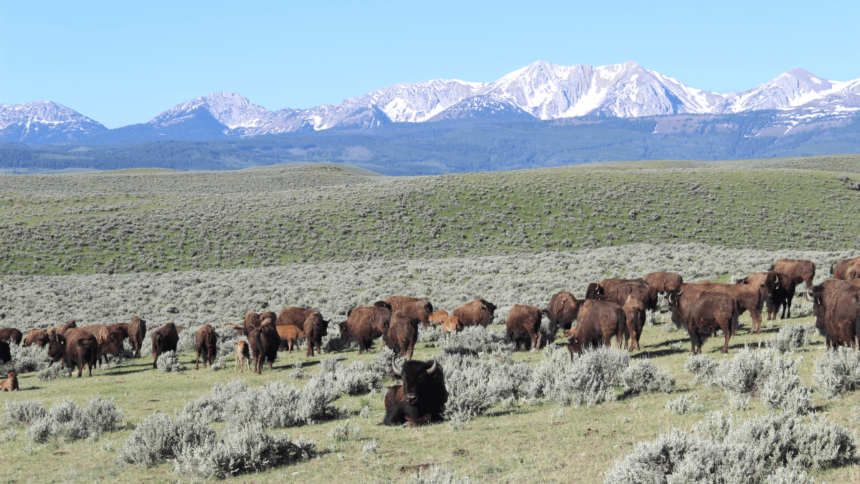WILSALL — In a pasture thick with yarrow, sagebrush, and wheatgrass, Montana Audubon’s Peter Dudley scribbled all the plant species he could identify onto his data sheet.
It was just before 5:30 a.m., and the grassland had a dull orange tinge as the sun rose over the Crazy Mountains. Dudley was about to start his mid-June bird survey on North Bridger Bison’s ranch, about 45 minutes outside Bozeman.
Dudley started his timer. He was silent as he listened for bird calls piercing the morning air. He used binoculars to watch the few birds flying by but mostly identified species based on their songs.
Dudley, a conservation ranching specialist, had camped on the ranch the night before with his colleague, Christian Meny, the director of conservation for Montana Audubon. Just before sunrise, Meny had gone to the other half of the ranch for his survey.
The expert birders were also here last June to document species for Audubon’s Bird-Friendly Ranching Certification. Last year, North Bridger Bison was the first bison ranch in Montana to receive the accolade. The certification recognized owners Matt and Sarah Skoglund for their management practices that support habitat for declining bird populations.
The program has certified more than 110 ranches across 15 states. There are 16 certified ranches in Montana, which receive a special Audubon label they can use to market their products.
Dudley’s timer beeped. In six minutes, he had documented 25 calls from six different bird species, including western meadowlarks, vesper sparrows, and sandhill cranes. He used a GPS to navigate to his next stop. The 20 points surveyed between Dudley and Meny were randomly generated to capture different habitats on the ranch, though two were specifically placed by ponds to survey riparian species.
Walking across the landscape, there was a clear difference between areas the bison had recently grazed and the pastures that had been left to let grass grow.
That’s the result of rotational, multi-pasture grazing, which creates a “mosaic” of habitats, Meny said. For example, some birds like vesper sparrows prefer short grasses that have been recently grazed, while others like Brewer’s sparrows are reliant on dense sagebrush for breeding. When grazing creates more varied habitats, that attracts a higher species of birds.
Audubon holds that landscapes like these — mostly privately held ranches — are key for struggling grassland birds. In the last 50 years, grassland bird populations have been cut in half, driven by the development and conversion of open range to tilled cropland, Meny said.
That’s why Audubon is recognizing how ranching can improve ecosystem health. When large, migratory bison herds grazed grasslands, they ate certain plants and trampled others, and their hooves helped press seeds into the soil. Bison manure and urine provided nutrients, and the animals would then leave for long periods. Over centuries, this system of disturbance and rest, according to Montana State University researchers and other ecologists, created the deep, fertile soils of the Great Plains.
To be sure, overgrazing can hurt ecosystems, Meny said. But grasslands evolved being grazed by ruminants — if left ungrazed, the land can see woody encroachment or be overtaken by invasive weeds. Some studies, including research published in the Crop and Pasture Science journal in 2023, have even found saliva in ruminants can stimulate the growth of certain grasses.
“This landscape evolved with high impact, short duration grazing, and then long recovery. And that’s the biomimicry we’re trying to do here on a much smaller scale,” said Matt Skoglund, owner of North Bridger Bison. “We’re trying to mimic nature and the way this landscape was historically grazed.”
Today, cattle play a similar ecological role to historic migrating bison. But having a bison ranch in the program is exciting because of some novel differences, Meny said. For example, bison herds tend to clump together more than cattle, making short grazing periods more intense. Bison fur left out on the range also makes great nesting material for birds.
The certification requires ranches to create a habitat management plan outlining their rotational grazing practices, which is verified by a third-party auditor. To Skoglund, writing that plan was easy because it was what the ranch was doing already.
This is the sixth summer of bison grazing on the ranch. This year, Skoglund plans to only graze each pasture once during the growing season for around a week or two. The ranch also doesn’t use any chemicals in an effort to build soil health. The result is a healthy ground cover and insect population that provides food for birds, Skoglund said.

And while landscape-wide change is slow, the rancher said he has already noticed a few shifts. For example, in the third year after letting the grass grow back on an overgrazed area around his house and barn, he started seeing several barn swallows building nests in the area. A pair of American kestrels are nesting in that barn, too. He once even saw a flock of about 25 sage grouse just south of the ranch.
Meny said the certification isn’t just about improving habitat, “it’s also about how can we keep this around.”
He gestured to the wide-open landscape. “Because ranches are much better than housing developments in terms of bird habitat, Montana has some of the last best grasslands left, and the reason for that is the livestock industry is healthy and thriving.”
The birders wrapped up their surveys around 10 a.m. and regrouped at their truck.
In total, Meny and Dudley had counted roughly 45 bird species – a few higher than last June’s count. But they emphasized that these changes are slow, and weather can impact counts from year to year. The early surveys aim to establish a baseline record of plant and bird species so long-term changes can be tracked.
As the birders were organizing their data sheets, Meny spotted a black dot whizzing over Saddle Peak in the Bridger Range. It was a golden eagle — the first of the day’s survey.
The colleagues, who can identify a bird just based on its wing shape, flight pattern, or song, said it took a lot of work to get there. For Meny, it’s been a lifelong interest. His second word, after “mama,” was “bird.”
“People come at it from a lot of different backgrounds,” Dudley added. “My background wasn’t in learning every bird. It was like, oh, I know what a blue jay call sounds like – maybe that’ll tell me there’s a fox nearby or a red-tail hawk flying over. That’s how I first caught the bug.”

In-depth, independent reporting on the stories impacting your community from reporters who know your town.
LATEST STORIES
FWP employee fired three months after being cleared of hunting-without-permission charge
Longtime FWP employee Michael Volesky, who most recently served as the agency’s chief of operations, said the department has no defensible cause for terminating his employment three months after a county attorney dropped the hunting without permission charges that purportedly led to the department’s decision to place Volesky on an extended period of administrative leave.
Tale of a changing West
Proponents say the gravel is desperately needed to complete road and construction projects in Gallatin County and Big Sky, a resort community about 40 miles further south on this winding highway. Detractors say it’s just another example of wealthy developers bending the law so they can build vacation homes on the doorstep of Yellowstone.
Blackfeet Tribe and Reclamation Bureau to share response at St. Mary Canal failure
The Blackfeet Tribe and the U.S. Bureau of Reclamation will work together to address the impacts of the St. Mary Canal siphon failures that disabled the Milk River Irrigation Project in June.





